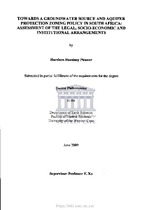| dc.contributor.advisor | Xu, Y. | |
| dc.contributor.author | Pienaar, Harrison Hursiney | |
| dc.date.accessioned | 2021-02-05T13:11:17Z | |
| dc.date.available | 2021-02-05T13:11:17Z | |
| dc.date.issued | 2009 | |
| dc.identifier.uri | http://hdl.handle.net/11394/7760 | |
| dc.description | Philosophiae Doctor - PhD | en_US |
| dc.description.abstract | The need for a fundamental change in our approach to water management in South Africa
is largely underpinned by the country's Constitution (Act 108 of 1996). Section 24 in
Chapter 2 of the Constitution is perhaps the most relevant to be considered when
developing a groundwater source and aquifer protection zoning policy, as it explicitly
endorses the right to have the environment protected. The mandate required to give effect
to the overall protection of South Africa's water resources spans across several sectors
and government departments, with expected roles and responsibilities not always clearly
defined. The Department of Water Affairs and Forestry (DWAF) is primarily responsible
for water resource management. However, the Department of Environmental Affairs and
Tourism (DEAn, the National Department of Agriculture (NDA) and the Department of
Provincial and Local Government (DPLG) are all key role-players because of their
respective responsibilities for biodiversity conservation, land management and
development planning across government. | en_US |
| dc.language.iso | en | en_US |
| dc.publisher | University of Western Cape | en_US |
| dc.subject | Water resource | en_US |
| dc.subject | Groundwater | en_US |
| dc.subject | Legislation, | en_US |
| dc.subject | Institutions | en_US |
| dc.subject | Economic | en_US |
| dc.title | Towards a groundwater source and aquifer protection zoning policy in South Africa: Assessment of the legal, socio-economic and institutional arrangements | en_US |
| dc.rights.holder | University of Western Cape | en_US |

